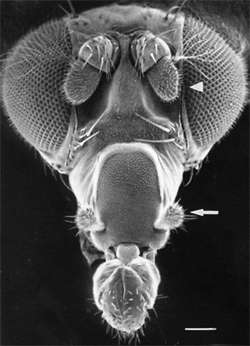November 22, 2012 report
Researchers find fly receptor neurons able to communicate without synapse connections

(Medical Xpress)—Researchers at Yale University have found that neural receptors in a fly's antenna are able to communicate with one another despite a lack of synaptic connections. They suggest in their paper published in the journal Nature that the communication between the neurons occurs via electrical signals transported by shared fluids.
Suspecting that the fluid filled hairs in the antennas of the fly, Drosophila melanogaster, called sensilla, might possess a property known as ephaptic coupling, where nerve cells communicate without a direct link, the researchers tested the abilities of several fly specimens in their lab. The first focused on two receptors located in the sensilla responsible for detecting fruity methyl hexanoate and banana-scented 2-heptanone, respectively. When exposed to methyl hexonate, they found that only the first receptor fired. If heptanone were suddenly introduced however, the first receptor ceased firing immediately as the second commenced indicating that some form of communication between the two was occurring. They found that the reverse worked as well. To rule out possible modes of communication, the researchers conducted the same experiment with flies that had their synapses disabled via drugs and with others that had had their antennas physically cut off. Both showed the same results indicating that the communication was not direct but was localized.
In another experiment the researchers blocked a neuron in a sensilla responsible for detecting vinegar which was situated next to a neuron responsible for detecting carbon dioxide (for avoidance). When placed in a maze with two arms that smelled of carbon dioxide and one of vinegar, the fly headed for the vinegar scented arm, showing that the vinegar disabled neuron was still able to communicate with its carbon dioxide detecting partner.
The researchers suggest such an ability in flies might help in figuring out which path to take when encountering an environment filled with many different options. They also suggest that neuron pairs in the sensilla might be communicating with one another via electrical signals. When one detects what it's supposed to detect, it sends a small charge into the fluid in which it and other neurons reside. That charge may then cause other neurons in the vicinity to go silent.
More information: Non-synaptic inhibition between grouped neurons in an olfactory circuit, Nature (2012) doi:10.1038/nature11712
Abstract
Diverse sensory organs, including mammalian taste buds and insect chemosensory sensilla, show a marked compartmentalization of receptor cells; however, the functional impact of this organization remains unclear. Here we show that compartmentalized Drosophila olfactory receptor neurons (ORNs) communicate with each other directly. The sustained response of one ORN is inhibited by the transient activation of a neighbouring ORN. Mechanistically, such lateral inhibition does not depend on synapses and is probably mediated by ephaptic coupling. Moreover, lateral inhibition in the periphery can modulate olfactory behaviour. Together, the results show that integration of olfactory information can occur via lateral interactions between ORNs. Inhibition of a sustained response by a transient response may provide a means of encoding salience. Finally, a CO2-sensitive ORN in the malaria mosquito Anopheles can also be inhibited by excitation of an adjacent ORN, suggesting a broad occurrence of lateral inhibition in insects and possible applications in insect control.
© 2012 Medical Xpress





















